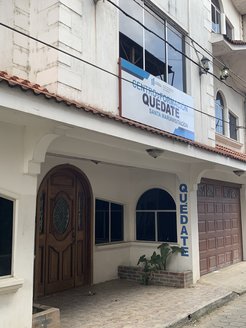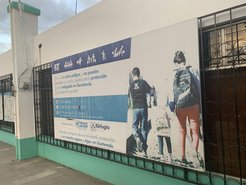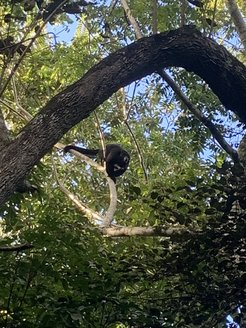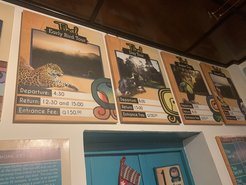
Resource frontiers in Guatemalan conservation
Julia C. Morris
Morris, Julia C. 2022. Resource frontiers in Guatemalan conservation. MoLab Inventory of Mobilities and Socioeconomic Changes. Department ‘Anthropology of Economic Experimentation’. Halle/Saale: Max Planck Institute for Social Anthropology. https://doi.org/10.48509/MoLab.6114
Download as PDF
Southern cross-border migration remains high on the United States’ political agenda. In her first trip abroad as Vice President, Kamala Harris went to Guatemala City, publicly discouraging undocumented migration from the region. In her now infamous speech at the Palacio Nacional de la Cultura, Harris stressed, ‘to folks in this region who are thinking about making that dangerous trek to the United States-Mexico border, do not come. Do not come. The United States will continue to enforce our laws and secure our border.’[1]

Since the Biden Administration entered office in 2021, there has been an increase in the numbers of people attempting to cross the U.S.-Mexico border. Last year, 17% of undocumented border crossers (279,033 people) were recorded from Guatemala: after Mexico and Honduras, the third most significant country of origin in the region.[2] Guatemala is not only categorised as a sending country but also a transit country, passed through by the majority of Central Americans, and increasingly Venezuelan and African migrants, in their passage to reach the U.S. As a result, Guatemala has become a key site in the U.S. government’s efforts to limit southern border migration. These strategies look to appease a polarised American electorate, riled by years of xenophobic – and often explicitly racist – discourses surrounding non-western immigration.
This entry discusses the role that biodiversity conservation is playing in the U.S. government’s efforts to keep would-be migrants in the region and limit their mobility northward. As part of their ‘Root Causes Strategy,’ the Biden Administration is financing efforts to advance local livelihoods in the Northern Triangle region of Central America: El Salvador, Guatemala, and Honduras.[3] These developmental practices include supporting an asylum system in Guatemala. Migrants (largely from El Salvador and Honduras) considering making an asylum claim are encouraged to do so in Guatemala, not the United States.
In 2021, Guatemala recorded the highest number of asylum applications since the country established a national asylum system in 2001: 800 applications, double that of the year before, but still low numbers in comparison to other regions around the world.[4] A number of state and private sector initiatives are then funded to provide long-term skills-building and livelihood opportunities for locals (particularly those who might migrate), internal migrants, and regional migrants given refugee status: including as protectors of Guatemala’s biodiversity.
Entangled Resources

Political boundaries are human constructs, but their production and enforcement is a ‘more-than-human endeavor.’[5] This entry accounts for the interplays between humans and more-than-humans, to use David Abram’s phrase.[6] Popularly adopted by the ecological movement and social scientists, more-than-humans is meant to denote a worldview beyond the anthropocentric that encourages humility on behalf of humankind, and takes non-human life and human/non-human entanglements seriously.[7] Such ways of thinking about ‘entangling relations with significant others’[8] compels more nuanced understandings of how living beings other than humans are subject to – and involved in – mobility governance in conservation sites. What I am proposing moves beyond anthropological discussions into the interface between humans and things that makes technologies possible, such as Latour’s actor-network theory[9] or Sundberg’s post-humanist political ecology.[10] My line of argumentation centres on the management of humans and more-than-humans as resources, whereby humans are just one of many actants entangled in extractive endeavours.
I look at these dynamics through the lens of ‘resource frontiers’ to emphasise how political, economic, and moral capital is extracted from humans and more-than-humans in the production of political barriers. I take the term ‘frontier’ to mean both a border, boundary, and line, as well as a zone of contact and exchange in order to attend to ideas of mobility, commerce, and sovereignty that exist in these spaces.[11] Mapping the dynamics of human/more-than-human resources and frontiering entails turning attention to what Cons and Eilenberg term ‘frontier assemblages,’ as ‘the intertwined materialities, actors, cultural logics, spatial dynamics, ecologies, and political economic processes that produce particular places as resource frontiers.’[12]
On (Human and More-Than-Human) Resource Management
The tropical forests of the north-eastern Petén region, the Maya Biosphere Reserve, make up the largest tropical forest north of the Amazon, and the largest protected area in Central America. Spread across 4.3 million acres, the park borders Mexico to the north and Belize to the east. I sit outside the offices of Conservation Rangers[13] on the edges of the region’s capital, Santa Elena: the main gateway to the Reserve and urban thoroughfare for Honduran migrants journeying northward. The sounds of revving jeeps are interspersed by howling monkeys in the jungle surrounds, as a group of Guatemalans and Honduran refugees prepare to head deep into the heart of the Reserve.
Conservation Rangers is a Guatemalan conservation NGO that has grown significantly in recent years. While other environmental NGOs scramble to stay afloat, Conservation Rangers has found success in pairing their pre-existing forest management programmes with initiatives designed for newly resettled refugees in the Petén. With the support of international and regional NGOs focused on asylum and refugee resettlement, their ‘Refugee Rangers’ programme has gained traction, lauded by the likes of Filippo Grandi, the Commissioner of the United Nations High Commissioner for Refugees, in his December 2021 visit to Guatemala.

In the Refugee Rangers programme, Guatemalans and Central American refugees – so far 70 refugees and an equal number of locals – are trained and employed as park rangers in ecological reserves around the country. As rangers, they are responsible for maintaining the trails used by visitors, monitoring sustainable logging practices, and native flora and fauna, which includes threatened animals such as Baird’s tapirs, scarlet macaws, and jaguars.
Although the programme is growing and gathering publicity, the low numbers speak to the symbolic capital of the refugee eco-protection spectacle. There is a disconnect between the scarcity of numbers and the tremendous publicity that such programmes accord: part of the heavy mediation of the refugee industry, in which peak resource narratives generally figure.[14] The U.S. and Guatemalan governments, and other institutional actors, profit from the political potency of representations of humanitarian philanthropy towards refugees and environmental discourses of conserving biodiversity. In fact, the Petén’s value is closely tied to politically justifying the governance of people’s mobility through what is sometimes described as ‘green washing’: whereby environmental benefits are emphasised to distract from the violence through which ecological reserves – but also border enforcement projects – emerge.[15] Destructive structures lurk within the entanglements across species and beings, in-so-far-as the management of humans and more-than-humans as resources can facilitate the governance of bodies in space. This entry challenges the alleged apoliticality of conservation initiatives to question: who do refugee-eco initiatives protect, under what conditions, and at what cost? By framing such patterns as resource frontiers, we might better understand practices where the governance of humans and more-than-humans explicitly collide.
Defining the Resource Frontier
The ‘resource frontier’ represents a vision of the US and the Guatemalan governments about what the border zone should become. It is also a project carried out by multiple state and private sector actors. As a vision and project, the ‘resource frontier’ encompasses two principal aspects. First, as a ‘resource,’ regions and populations are turned into subjects of investment and sources of profit.[16] Second, as a ‘frontier,’ the border is redefined as a space of experimentation, investment and management, and the deterrence of unwanted northward mobility.[17] The rhetoric of ‘frontiers’ is utilised by state agencies, corporations, NGOs, and development banks in promoting regions – and not least the Petén – as a ‘frontier’ for investment. Indeed, the Petén holds a colonial history as a zone of beckoning for investment opportunity, underneath which occurred the displacement, dispossession, and enclosure of Indigenous groups.[18] Institutionalised conservation radically altered land use patterns and compelled Indigenous Maya to become part of markets, in particular for elite global tourism in the Reserve.[19] To this day, local landscapes, bodies, and beings are continuously crafted as resourceful in the Petén. As the region and livelihoods are redeployed as sites for eco-protection, the (im)mobility of humans and more-than-humans are tied together through conservation activities.[20]
Bodily (im)mobilities are a crucial part of these systems, whereby populations are (im)mobilised in order to enable the mobility of other bodies, creatures, life forms, and commodities.[21] In the Petén – a region viewed as a migration crossroads to the U.S. – migrants and Guatemalan participants are subject to practices of ‘regulation by territorialisation’: fixed in place through conservation.[22] Local – majority Indigenous – populations have long been defined as bodies ‘out-of-place’ in an ecotourism paradise that many argue has not provided the promised benefits, but rather is socially damaging.[23] Contemporary territorial projects build onto and rework past practices, drawing on imposed ideals of pristine wilderness.[24]
Contradictions of Resource Protection
Projects such as those of Conservation Rangers have become important vehicles that bring local residents and regional migrants together as part of a culture of protection for the land, water, soil, plants, animals, and each other. Conservation Rangers also offers regional protection for migrants leaving unsustainable living conditions in surrounding regions. Yet simultaneously, the programme sits neatly within the U.S. government’s Quédate extractive strategies. Political economic value is extracted in the representation of ‘protecting’ global northern regions from poor migrants of colour from the global south, while also supporting elite tourist economies in the Reserve.

These programmes raise important questions around the political work being done by more-than-human actors. Human and more-than-human entities are often operationalised in boundary making and enforcement projects.[25] The refugee ranger programme might bring local livelihood opportunities. Yet, it is also a means of governing people’s mobility. The drive to ‘civilize, territorialize and categorize nature’ were, of course, central principles and forces that animated the proliferation of national parks.[26] The eco-refugee initiative shares similarities as a ‘civilizing mission’ that draws together asylum, border enforcement, and conservation regimes. Conservation organisations might represent their work as protecting nature and people, rather than as a sort of ‘fortress conservation’[27] or resource extraction justified by ecological and humanitarian rationales.[28] But the ‘discovery’ of global human and more-than-human commodity supplies also redeploys ecological spaces into ‘zones of opportunity.’[29] As humans and more-than-humans intermingle as resources – categorised and territorially fixed in place for political, economic, and moral value – questions of governance and protection blur significantly.[30] This is all part of the current moment of frontier expansion, whereby sovereignty is performed through all manner of practices and technologies, including modes of environmental protection.
[1] Harris, Kamala and Guatemala President Alejandro Giammattei. 2021. Press Conference Transcript. 7 June 2021. Available online at: https://www.rev.com/blog/transcripts/kamala-harris-guatemala-president-alejandro-giammattei-press-conference-transcript-june-7. Last accessed on 31 March 2022.
[2] Pew Research Center. 2021. What’s happening at the U.S.-Mexico border in 7 charts. Available online at: https://www.pewresearch.org/fact-tank/2021/11/09/whats-happening-at-the-u-s-mexico-border-in-7-charts/. Last accessed on 31 March 2022.
[3] See the U.S. Strategy for Addressing the Root Causes of Migration in Central America. 2021. Available online at: https://www.whitehouse.gov/wp-content/uploads/2021/07/Root-Causes-Strategy.pdf. Last accessed on 31 March 2022.
[4] United Nations High Commission for Refugees. 2021. Fact Sheet: Guatemala. Available online at: https://reliefweb.int/sites/reliefweb.int/files/resources/UNHCR%20Guatemala%20Fact%20sheet%20September%202021.pdf. Last accessed on 31 March 2022.
[5] Sundberg, Juanita. 2011. Diabolic Caminos in the Desert and Cat Fights on the Río: A Posthumanist Political Ecology of Boundary Enforcement in the United States–Mexico Borderlands. Annals of the Association of American Geographers 101 (2), 318.
[6] Abram, David. 1996. The Spell of the Sensuous: Perception and Language in a More-than-Human World. New York: Random House.
[7] Bastian, Michelle, Owain Jones, Niamh Moore, and Emma Roe, eds. 2017. Participatory Research in More-than-Human Worlds. Abingdon: Routledge.
[8] Tsing, Anna. 2013. More-than-Human Sociality: A Critical Description. In: Anthropology and Nature, edited by Kirsten Hastrup. London: Routledge, 27.
[9] Latour, Bruno. 1996. Aramis, or the Love of Technology. Translated by C. Porter. Cambridge: Harvard University Press.
[10] Sundberg, Juanita. 2011.
[11] Saraf, Aditi. 2020. Frontiers. Oxford Research Encyclopedia of Anthropology. Available online at: https://doi.org/10.1093/acrefore/9780190854584.013.145. Last accessed on 31 March 2022.
[12] Cons, Jason and Michael Eilenberg. 2019. Frontier Assemblages: The Emergent Politics of Resource Frontiers in Asia. Hoboken, NJ: Wiley, 2.
[13] Not the organisation’s real name.
[14] Morris, Julia. 2021. The Value of Refugees: UNHCR and the Growth of the Global Refugee Industry. Journal of Refugee Studies 34 (3): 2676-2698.
[15] Van Isacker, Travis. 2020. Counter-mapping Citizenship: Bordering Through Domicide in Calais, France. Doctoral Thesis, University of Brighton.
[16] Barney, Keith. 2009. Laos and the making of a ‘relational’ resource frontier. The Geographical Journal 175 (2): 146–159; Kelly, Alice B. and Nancy Lee Peluso. 2015. Frontiers of Commodification: State Lands and Their Formalization.
[17] Reeves, Madeleine. 2014. Border Work: Spatial Lives of the State in Rural Central Asia. Ithaca: Cornell University Press.
[18] Grandia, Liza. 2012. Enclosed: Conservation, Cattle, and Commerce among the Q'eqchi' Maya Lowlanders. Seattle: University of Washington Press.
[19] Devine, Jennifer. 2014. Counterinsurgency Ecotourism in Guatemala's Maya Biosphere Reserve. Environment and Planning D: Society and Space 32 (6): 984-1001.
[20] Labban, Mazen. 2010. Oil in Parallax: Scarcity, Markets, and the Financialization of Accumulation. Geoforum 41 (4): 541-552; Morris, Julia. 2021. The Value of Refugees: UNHCR. and the Growth of the Global Refugee Industry. Journal of Refugee Studies 34 (3): 2676-2698.
[21] Sheller, Mimi. 2003. Consuming the Caribbean: From Arawaks to Zombies. London: Routledge.
[22] Bassett, Thomas J. and Denis Gautier. 2014. Regulation by Territorialization: The Political Ecology of Conservation & Development Territories EchoGéo 29.
[23] Ybarra, Megan. 2017. Green Wars: Conservation and Decolonization in the Maya Forest. Berkeley: University of California Press.
[24] Neumann, Roderick P. 1998. Imposing Wilderness: Struggles Over Livelihood and Nature Preservation in Africa. Berkeley: University of California Press.
[25] Sundberg, Juanita. 2011.
[26] Gissibl, Bernhard, Patrick Kupper, and Sabine Höhler, eds. 2012. Civilizing Nature: National Parks in Global Historical Perspective. New York: Berghahn Books, 2.
[27] Brockington, Dan. 2002. Fortress Conservation: The Preservation of the Mkomazi Game Reserve, Tanzania. Bloomington: Indiana University Press.
[28] Lunstrum, Elizabeth, Pablo Bose and Anna Zalik, 2016. Environmental displacement: the common ground of climate change, extraction and conservation. Area 48 (2): 130-133.
[29] Tsing, Anna. 2003. Natural Resource and Capitalist Frontiers. Economic and Political Weekly, 38 (48), 5100.
[30] Kelly, Alice B. and Megan Ybarra. 2016. Introduction to Themed Issue: “Green Security in Protected Areas.” Geoforum 69: 171–175.
This is an Open Access article, distributed under the terms of the Creative Commons Attribution licence (https://creativecommons.org/licenses/by/4.0/), which permits unrestricted re-use, distribution, and reproduction in any medium, provided the original work is properly cited.



